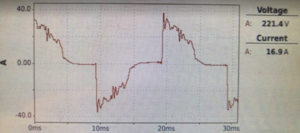Click here to register!
LED Lights in Off-grid Applications
Introduction
At first glance, AC operated LED seem the perfect choice for AC off-grid systems. Their efficiency can reach 120-160 lumen per Watt (as per 2017), their life expectancy is claimed to be between 20'000h and 50'000h, largely exceeding in both regards any competing technology like fluorescent, sodium arc or metal halide. Compared to the latter two, LEDs also are much more scalable (from bulbs or strips with a few Watts to full sports stadium lighting) and demand less careful operations.
A further advantage of AC-LED lights over other lighting technologies is their gret tolerance to voltage and frequency fluctuations, a condition that often occurs in microgrids, where there is part time availability of a grid of low reliability.
Issues with LED Lights in AC Off-grid Applications
Any relatively small amount of LED lights in an inverter based off-grid system ('small' meaning total power consumption of the LED lights as compared to the total inverter power) poses normally no issues. But since AC LED lights are equipped with an electronic AC to DC converter, their current consumption is not sinoidal (resistive) at all. Often, the necessary energy needed to operate the light during a 10ms halfwave (@50Hz)is drawn in a short current peak, usually at the beginning of the halfwave. After that short peak, for the rear of the halfwave, the power electronics does not draw any more current from the AC supply.
Even worse can be the effests of the inrush current of the AC-DC converters. This becomes relevant, when one is building large lighting systems as off-grid application, where most -if not all- of the loads are LED lights.
Usually, the desired mode of operation of such systems is, that all lights are switched on at the same time, usually timed by a timer or a luminosity detector.
Thus follows, that often all of the LED lights should be switched on at the very same moment, multiplicating the problem of inrush current by the number of lights installed.
This inrush current, that can -for a few milliseconds- be 20-50 time higher than the nominal current, is the reason why it is generally recommended to use MCB (circuit breakers) of C-curve behaviour, being more tolerant to such short but very high current peaks.
To compensate for the non-sinoidal current drawn (crest-factor[1]) it may be necessary to oversize the DC-AC inverter, so it does not get overloaded with the maximum peak current.
Mitigating Measures
- Cascading groups of LED lights, either by several manual switches, so that simultanious activation is virtually impossible, or by relais with short delay timers.
- Over-sizing of MCBs, Inverter power and switching contacts.
- Inrush-current limiters (some are specific for LED lighting)
- Long stretches of wires from source (inverter) to the lights usually act as an inductivity in series, diminuishing current peaks. This -normally unwelcome- inductivity of the wiring can be a convenient help to avoid inrush currents.
Further Information
References:
Excellent test protocol of LED lamps, at different starting angles:
http://www.olino.org/us/articles/2013/10/22/inrush-current-for-led-light-bulbs
Technical note from the lighting association UK concerning MCBs protecting LED lighting: TS31 - Use of MCBs with circuits containing LED ECGs 3-6-2014.pdf https://www.thelia.org.uk/sites/default/files/resources/LIA TS31 - Use of MCBs with circuits containing LED ECGs 3-6-2014.pdf




















